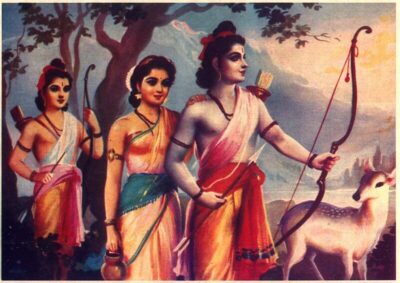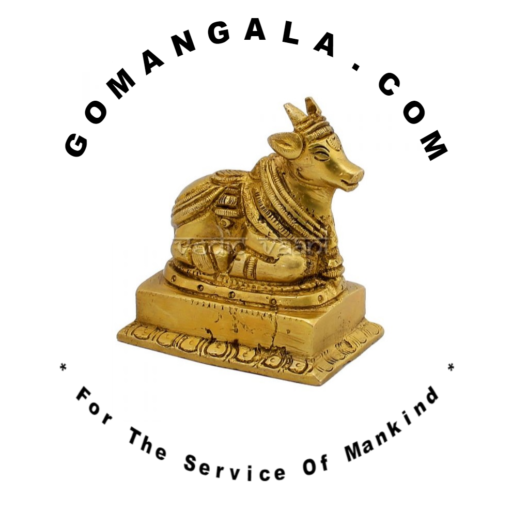Ayodhya was the capital city of Rama but his education was not yet completed when Vishwamitra Rishi had visited the Palace of Dasharatha. Vishwamitra Rishi was in search of an efficient man, say a prince, who possessed healthy habits. He had collected the data about Rama and selected him as a suitable person for his desired purpose of actions. Rama was not married then. He was always found accompanied by his younger brother Lakshmana. His character, conduct and integrity were beyond doubt and are not a matter to narrate, but his habits would be emphasized here. Habits could be practiced by observing a guide. Healthy human habits would certainly please the surrounding people and create a healthy society that would be able to cause longevity and happiness in life.

After convincing Dasharatha and his kinsmen, Vishwamitra had succeeded in getting the efficient boy or prince Rama and started their journey to the Ashram of Vishwamitra. Lakshmana had also accompanied them willingly. The queen Sumitra, the mother of Lakshmana felt really happy since she had confidence in Rama and her younger son Shatrughna had already been with her to assist her. Now the habits displayed by them are really notable. Even though Shatrughna was the youngest, he had learnt the required lessons befitting as the prince of Ayodhya. He was an unassuming king of Ayodhya. While moving from the palace to the Ashram of Vishwamitra Rishi, the trio had walked keeping the social distances. Several verses in Ramayana had stressed the importance of keeping social distance while in the company of people which showed the primitiveness of that habit among the people then.
The next notable habit was wearing the cover gloves for protection of physical body and organs. People used helmet in a sense and no bare head could be seen anywhere during the events of Ramayana. However exceptions would occur in the case of Rama, Lakshmana and Vishwamitra who had not worn any crown or helmets. Since the grown hair tied in provided natural protection, helmets were not required for them.
Valmiki Rishi had explained in verses, the trio had moved like mythological serpents holding their hoods up, and steadily advanced on the ground. Even though the handle of the bow had a golden cover, Rama had used a pair of leather gloves, to cover his hands and fingers.
तदा कुशिकपुत्रं तु धनुष्पाणी स्वलंकृतौ । बद्धगोधांगुलित्राणौ खड्गवंतौ महाद्युती ॥
Meaning: Vishwamitra Rishi and Rama had held beautifully, in their hands, the bow, their palm and fingers were covered with gloves, the person, Lakshmana looked ahead, had held the sword, also worn gloves.
Healthy habits had been cultivated in the good presence of Vishwamitra Rishi. In the forests then, cannibals were common and human flesh eaters were the obstacles for the life of Rishis. The situations faced by them in the childhood had taught them to deal with the man eaters in later times, when they had to spend in the dense forests of Dandakaranya which were ruled by demons of Lanka.
Accompanying working tools always would be a good habit. God Vishnu had four hands but none of them were empty. Conch, Wheel, Mace and lotus flowers are not only symbols, but also the working tools for him. When a stethoscope is put on the shoulders, extra explanation is not required in the case of a physician.
Greetings
In the standing posture, if the person had the equal rank, then a simple Namaste with joined hands would be sufficient for the first greeting. There was no shaking hands system in the past in this country. No embracing at all anywhere but was found in the land of demons only. During the centuries in the past, the drama troops had modified many verses for making the drama sceneries more attractive with flattery items in the epics. Some theatrical attractions had also changed the truth and were presented to us.
There was no sense of untouchable feeling within the people but normally, human beings had not touched one another physically. Shukracharya was the teacher, where the son of Deva Guru Brihaspathi, with name Kacha had come to learn the lessons of Amrithasanjivini. Kacha and the daughter of Shukracharya, Devayani were educated in the same school under coeducation system but one should never touch the body of the other as was the symbol of social distance.
Greetings of gentlemen were called Sashtanga Pranama. The eight parts of the organs of the gentlemen would be touching the ground during the prostrating, in front of the respected to be honored. When Rama and Lakshmana had visited Agastya Muni they prostrated as Sashtanga pranam:
शिरसा उरसा दृष्ट्या मनसा वचसा तथा । पद्भ्यां प्राणाभ्यां कराभ्यां प्रणामो ऽष्टांग मुच्यते ॥ पुरुषाणां ॥
Meaning: With forehead, thighs, eyes, heart or chest, mouth, pairs of feet, nose, and pairs of hands or palms thus eight parts of their body had touched the ground (Gentlemen).
With them, Sita also prostrated before Agastya Muni, but only five parts of her body could touch the ground:
शिरसा दृष्ट्या पद्भ्यां तथा प्राणाभ्यां । कराभ्यां प्रणामो पंचांग मुच्यते ॥ स्त्रीणां ॥
With forehead, eyes, pairs of feet, nose, and pairs of hands or palms, thus five parts of her body had touched the ground. (Ladies: omitted are thighs, chest and mouth)
Agastya Muni had praised the healthy habits of Sita and suggested to live in Panchavati Forests and provided them the Vishnu bow for self-protection.
As their guests, Agastya Muni had provided them food after his fire worship:
अग्निं हुत्वा प्रदायार्घ्यमतिथीन् प्रतिपूज्य च । वानप्रस्थेन धर्मेण सतेषां भोजनं ददौ ॥
Meaning: After giving water to wash their hands, putting the cow ghee into the fire oblations, worshipped them and served them food, as according to his guests.
Thus it would be always better to use protective devices and observe social distance.
It is humbly prayed for the blessings of God Rama upon us.
Next post, being Nanda Deepa, meaning ever glowing lamp, may not be missed.
Readers may provide feedback and share this story with friends and family.

Great🙏